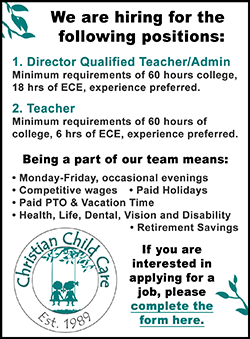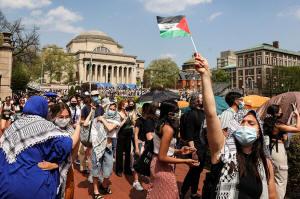New York City said 'no injuries' at Columbia arrests; students' medical
records say otherwise
 Send a link to a friend
Send a link to a friend
 [May 17, 2024]
By Jonathan Allen [May 17, 2024]
By Jonathan Allen
NEW YORK (Reuters) - After the arrests of pro-Palestine student
protesters occupying a Columbia University building last month, New York
Mayor Eric Adams and senior police officials repeatedly said there were
"no injuries," no "violent clashes" and minimal force used.
But at least nine of the 46 protesters arrested inside the barricaded
Hamilton Hall on April 30 sustained injuries beyond minor scrapes and
bruises, according to medical records, photographs shared by protesters,
and interviews. The documented injuries included a fractured eye socket,
concussions, an ankle sprain, cuts, and injured wrists and hands from
tight plastic flexicuffs.
All of the 46 protesters arrested inside Hamilton were charged with
third-degree trespass, a misdemeanor. The arrests came after Columbia
President Minouche Shafik, in a hotly debated decision, called in police
hours into the occupation at the epicenter of a student protest movement
that has spread to campuses around the world. Other university officials
across the country also have called in police to quell pro-Palestinian
and anti-Israel protest camps.
Reuters shared details of the protesters' injuries and accounts with the
mayor's office, New York police and Columbia. None disputed the
injuries. The mayor's office and the police said officers acted
professionally.
At least three injured protesters arrested inside Hamilton were taken by
police to hospitals that night while still in custody, time-stamped
hospital records show.
Other protesters, who are demanding Columbia divest from arms makers and
other companies that support Israel's government, had their injuries
documented by volunteer doctors who provide support to people arrested
by police and met them outside moments after their release from custody
on May 2. Some then sought medical attention at clinics.
"I was slammed downward to the ground and, when I turned my head to see
if there were any comrades who needed assistance, an officer kicked me
in the eye and I went straight down, and there was that buzzing and
sharp ringing in the ears," said Christopher Holmes, a 25-year-old
graduate student at the Columbia affiliate college Union Theological
Seminary. Moments later, an officer slammed the left side of his
forehead into the floor of Hamilton Hall, Holmes said.

His eye still swollen days after his release, a friend took him to a
Manhattan hospital. Hospital records show doctors determined his eye
socket was fractured and that he was concussed.
'WE ARE UNARMED!'
Kayla Mamelak, a spokesperson for the mayor, declined to say when the
mayor first learned that protesters had been injured. At a May 1 press
conference with police leaders, Adams said the arrests were "organized,
calm, and that there were no injuries."
[to top of second column]
|

Students march and rally on Columbia University campus in support of
a protest encampment supporting Palestinians, despite a 2pm deadline
issued by university officials to disband or face suspension, during
the ongoing conflict between Israel and the Palestinian Islamist
group Hamas, in New York City, U.S., April 29, 2024. REUTERS/Caitlin
Ochs/File Photo

Mamelak wrote in an email that the arrests, which involved hundreds
of armed officers in riot gear, were "a complicated operation"
handled "with professionalism and respect."
A police spokesperson, who declined to give their name, also did not
dispute the protesters' injuries, writing in an email that officers
responded "swiftly, professionally, and effectively."
Both spokespeople declined to provide unedited videos from officers'
body-worn cameras and use-of-force and injuries reports from the
arrests. That night, police ordered students outside Hamilton into
dormitories and forced journalists off campus.
Columbia spokesperson Ben Chang said he would answer Reuters queries
by May 10, but did not send replies by that date and did not respond
to subsequent emails and phone calls.
As police used electric saws to cut through barricades of heavy
furniture and bike chains, several protesters said they sat on the
floor in Hamilton's lobby, hands raised. Police threw in a
flash-bang grenade, setting off disorienting loud bangs and bursts
of light, before rushing through the doors.
Gabriel Yancy, a 24-year-old research assistant who has since been
fired from his job in a Columbia neuroscience laboratory, said he
watched officers throw some protesters to the ground, step on at
least three protesters, and kick at least one in the torso.
Aidan Parisi, a 27-year-old student in Columbia's social work
department, recalled police "stepping on top of people, throwing
people," and said that several protesters yelled, "We are unarmed!"
Several students said officers knelt forcefully on their backs. New
York City passed a law in 2020 prohibiting police from using knee
restraints that compress the diaphragm.
Gideon Oliver, a civil rights lawyer who now represents some of the
arrested students, was involved in a reform agreement that the New
York state attorney general reached with the New York Police
Department last year to end its "pattern of excessive force" against
protesters.
"Now is the time for the city and for the police department to
deescalate and to stop engaging in tactics on the streets that
appear designed to chill protests," Oliver said.
(Reporting by Jonathan Allen; Editing by Leslie Adler)
[© 2024 Thomson Reuters. All rights reserved.]This material
may not be published, broadcast, rewritten or redistributed.
Thompson Reuters is solely responsible for this content.
 |